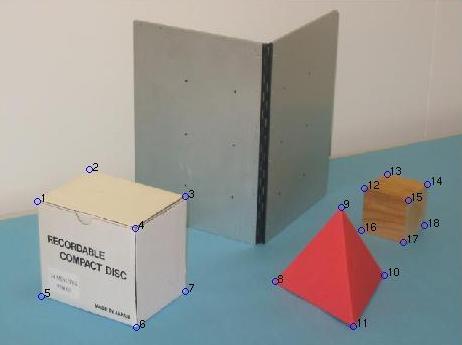

In this lab exercise you will use the calibration data calculated in Lab 7 on the images, stereo1.jpg and stereo2.jpg to reconstruct 3D information about the scene in these images.


Listing of stereo.m
% STEREO % % Usage: pt3D = stereo(im1, im2, C1, C2) % % Where: im1 and im2 are the two stereo images % C1 and C2 are the calibration matrices % for these two images respectively % % The function will prompt you to digitise some points in the first image % (finishing by clicking the right button). The function then % prompts you to digitise the equivalent points (which you must digitise % in exactly the same sequence) in the second image. % The function then solves the stereo equations % and returns the 3D coordinates of the points in pt3D. function pt3D = stereo(im1, im2, C1, C2) fprintf(1, 'Digitise some points in figure 1\n'); figure(1) imshow(im1); [u1,v1] = digipts; fprintf(1, 'Digitise some points in figure 2\n'); figure(2) imshow(im2); [u2,v2] = digipts; % check if same number of points are selected if length(u1) ~= length(u2) fprintf(1, 'Same number of points not selected\n'); end for i = 1:length(u1) a = [C1(1:2,1:3) - [u1(i)*C1(3,1:3); v1(i)*C1(3,1:3)]; C2(1:2,1:3) - [u2(i)*C2(3,1:3); v2(i)*C2(3,1:3)]]; c = [u1(i) - C1(1,4); v1(i) - C1(2,4); u2(i) - C2(1,4); v2(i) - C2(2,4)]; b(:, i) = a \ c; end pt3D = b';
pt3D = [-287.4992 158.1141 143.3739
-173.9468 164.2097 143.1560
-175.3143 14.7507 141.1366
-290.1675 12.2712 143.6394
-285.8033 160.3430 8.2383
-286.8887 12.2176 6.3721
-172.2206 15.0332 3.4689
-86.0006 -70.0496 1.0623
-68.9215 -147.1819 125.1224
20.7269 -179.1217 -4.6303
-137.1235 -207.1395 -0.1451
134.8328 -92.2062 63.3233
207.7907 -93.5088 61.5312
209.3196 -159.1696 58.2119
137.6326 -155.7202 58.6228
135.9920 -92.8646 -6.4432
136.2160 -159.7846 -9.3104
206.6607 -163.1632 -10.7436]
I will first go through the code I used to obtain the lengths,
% pt3D contains the coordinates of each unique vertex
% a face matrix specifies how to connect these vertices to form sides.
%
% hence for a cube (following the given numbering), in general we have
% cubefaces = [4 1 2 3
% 4 3 7 6
% 4 6 5 1
% 8 5 1 2
% 8 2 3 7
% 8 7 6 5];
% similarly for a tetrahedron, we have
% tetrahedronfaces = [1 2 3
% 1 2 4
% 1 3 4
% 2 3 4];
%
% hence we can make a function that determines the lengths of a face
% by inputing the vertex and face matrix.
function [slengths, nface] = sidelengths(pt3D, face)
[rows, cols] = size(face);
nface = [face face(:,1)];
for i=1:cols
for j=1:rows
slengths(j,i) = norm(pt3D(nface(j,i),:)-pt3D(nface(j,i+1),:));
end
end
end
The results obtained for the box, tetrahedron, and cube where as follows:
Length matrix of box face sides
slengths =
145.8540 110.3015 144.8299 114.4853
114.4853 134.3559 113.9037 135.9337
135.9337 149.6496 133.8096 145.8540
112.5680 133.8096 110.3015 135.9337
135.9337 144.8299 134.3559 146.6334
146.6334 113.9037 149.6496 112.5680
nface =
4 1 2 3 4
4 3 7 6 4
4 6 5 1 4
8 5 1 2 8
8 2 3 7 8
8 7 6 5 8
Length matrix of tetrahedro face sides
slengths =
147.7079 160.2307 152.0356
147.7079 154.4157 149.1688
152.0356 158.6128 149.1688
160.2307 158.6128 154.4157
nface =
1 2 3 1
1 2 4 1
1 3 4 1
2 3 4 2
Length matrix of cube face sides
slengths =
66.8509 68.1830 61.4854 74.5177
74.5177 67.2932 74.1407 68.4982
68.4982 67.2958 67.7235 66.8509
67.8666 67.7235 68.1830 68.4982
68.4982 61.4854 67.2932 62.7262
62.7262 74.1407 67.2958 67.8666
nface =
4 1 2 3 4
4 3 7 6 4
4 6 5 1 4
8 5 1 2 8
8 2 3 7 8
8 7 6 5 8
Hence for the cube, we convert the vertices to the standard, where the vertices are labeled the same as the box.
Then looking at the nface matrix the length between vertice 4 and 1 corresponds to a length of 66.8509, the length between vertice 1 and 2 corresponds to a length of 68.1830, and so on...
lab8.m used for wireframe images
lab8colour.m used for above images